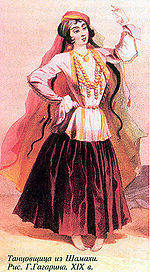| Revision as of 14:59, 2 August 2023 view source2a02:aa1:1626:cadd:1575:4a89:9490:c616 (talk) Again for what reason are you changing it? You haven’t shown a single reason for your change. Editing to fit your own Armenian beliefs is just embarrassing.Tags: Manual revert Reverted Mobile edit Mobile web edit← Previous edit | Latest revision as of 01:04, 2 November 2024 view source Monkbot (talk | contribs)Bots3,695,952 editsm Task 20: replace {lang-??} templates with {langx|??} ‹See Tfd› (Replaced 3; ignored 1: Lang-ka);Tag: AWB | ||
| (24 intermediate revisions by 13 users not shown) | |||
| Line 1: | Line 1: | ||
| {{pp-semi-indef}} | |||
| {{short description|Traditional dress of the peoples of the Caucasus and Iran}} | {{short description|Traditional dress of the peoples of the Caucasus and Iran}} | ||
| ] wearing an arkhalig]] | ] wearing an arkhalig]] | ||
| An '''arkhalig''' |
An '''arkhalig''' {{Efn|{{langx|hy|արխալուղ}}, {{langx|az|arxalıq}}, {{lang-ka|ახალუხი}}, {{langx|fa|ارخالق}}}} is part of both male and female traditional dress of the ] and ]. The arkhalig originated from the ''beshmet'', a ] outer clothing later worn by ]s. | ||
| An arkhalig is a long tight-waist jacket made of various kinds of fabric, such as ], ], ], ] and ], traditionally depending on the social status of its owner. |
An arkhalig is a long tight-waist jacket made of various kinds of fabric, such as ], ], ], ] and ], traditionally depending on the social status of its owner. Male arkhaligs can be both single-breasted (done up with ]) and double-breasted (done up with buttons). In cold weather, a ] is put on above an arkhalig. Female arkhaligs are often ] and have tight long sleeves widening on the wrists. A female arkhalig can also include a fur list along the edges, patterned laces and braids, or be decorated with gold embroidery. | ||
| In the arkhalıq, there are true sleeves, either cut plain, or plain to the elbow and then slit as far as the wrist or, in the type called lelufar (Persian language, nīlūfar that means ]), flared from the elbow like the bell of a lily and trimmed with an extra 4 cm of lining from the inside.<ref name=Andrews92>{{cite encyclopedia |last=Andrews & Andrews |first=P. A. & M. | title= CLOTHING xxi. Turkic and Kurdish clothing of Azerbaijan | encyclopedia=Encyclopædia Iranica | accessdate=2011-10-12|url=http://www.iranicaonline.org/articles/clothing-xxi}}</ref> | In the arkhalıq, there are true sleeves, either cut plain, or plain to the elbow and then slit as far as the wrist or, in the type called lelufar (Persian language, nīlūfar that means ]), flared from the elbow like the bell of a lily and trimmed with an extra 4 cm of lining from the inside.<ref name=Andrews92>{{cite encyclopedia |last=Andrews & Andrews |first=P. A. & M. | title= CLOTHING xxi. Turkic and Kurdish clothing of Azerbaijan | encyclopedia=Encyclopædia Iranica | accessdate=2011-10-12|url=http://www.iranicaonline.org/articles/clothing-xxi}}</ref> | ||
| Arkhaligs were in wide use until the 1920s. | Arkhaligs were in wide use until the 1920s.{{cn|date=August 2023}} | ||
| ==Note== | |||
| <references group="lower-alpha" /> | |||
| ==References== | ==References== | ||
Latest revision as of 01:04, 2 November 2024
Traditional dress of the peoples of the Caucasus and Iran

An arkhalig is part of both male and female traditional dress of the peoples of the Caucasus and Iran. The arkhalig originated from the beshmet, a Turkic outer clothing later worn by Cossacks.
An arkhalig is a long tight-waist jacket made of various kinds of fabric, such as silk, satin, cloth, cashmere and velvet, traditionally depending on the social status of its owner. Male arkhaligs can be both single-breasted (done up with hooks) and double-breasted (done up with buttons). In cold weather, a chokha is put on above an arkhalig. Female arkhaligs are often ornamented and have tight long sleeves widening on the wrists. A female arkhalig can also include a fur list along the edges, patterned laces and braids, or be decorated with gold embroidery.
In the arkhalıq, there are true sleeves, either cut plain, or plain to the elbow and then slit as far as the wrist or, in the type called lelufar (Persian language, nīlūfar that means lily), flared from the elbow like the bell of a lily and trimmed with an extra 4 cm of lining from the inside.
Arkhaligs were in wide use until the 1920s.
Note
- Armenian: արխալուղ, Azerbaijani: arxalıq, Georgian: ახალუხი, Persian: ارخالق
References
- Andrews & Andrews, P. A. & M. "CLOTHING xxi. Turkic and Kurdish clothing of Azerbaijan". Encyclopædia Iranica. Retrieved 2011-10-12.